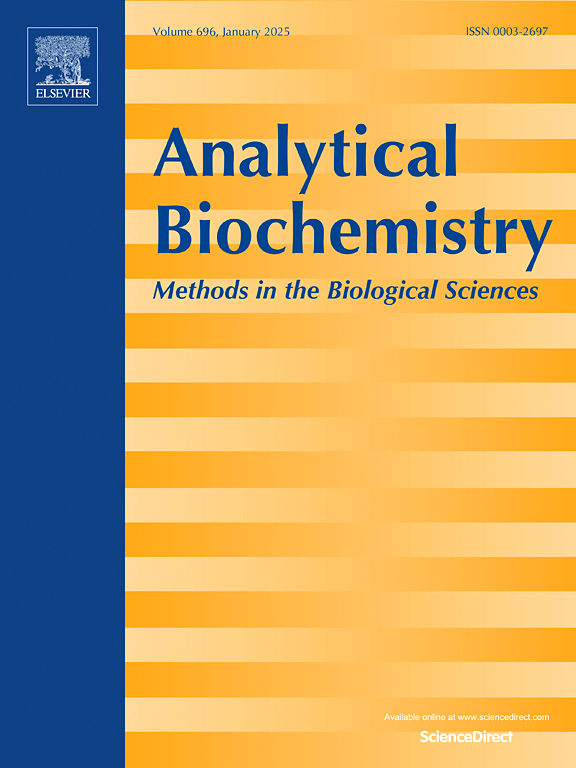利用过氧化物酶样MnFe2O4@CrFe2O4纳米复合材料的新型双功能可持续的H2O2测定和染料生物矿化方法
IF 2.5
4区 生物学
Q2 BIOCHEMICAL RESEARCH METHODS
引用次数: 0
摘要
本文设计并开发了一种新型的双功能可持续绿色纳米酶介导的方法,利用具有协同过氧化物酶样活性的高活性MnFe2O4@CrFe2O4纳米复合材料,用于高灵敏度和选择性的H2O2定量和可重复使用的罗丹明B生物矿化。该方法还引入了一种可持续的方法来探测分析物,而不是利用流行的致癌纳米酶分析探针,使其绝对比传统方法更具可持续性。过氧化氢生物传感器的线性范围为1 ~ 100 μM,检测限为0.6 μM,日间RSD为2.74%,对共存材料具有高选择性响应。最终将该传感器用于牛奶中H2O2的定量,回收率为96.1 ~ 102.8%,%RSD = 1.4 ~ 3.6%。此外,对影响脱色率的因素进行了优化,在最佳实验条件下,在35.0 min的短时间内,生物矿化率达到99.4%。对纳米酶的突破体积、储存稳定性和可重复使用性进行了评估,结果表明,纳米酶的突破体积为5.0-1000 mL,保质期为20天,10次循环后产量节约70%。将该方法应用于河流、池水、自来水等实际水介质中染料的降解,收率达95.4 ~ 99.5%以上,%RSD = 1.8 ~ 4.2%。本文章由计算机程序翻译,如有差异,请以英文原文为准。

A novel dual-function sustainable method for H2O2 determination and dye biomineralization utilizing peroxidase-like MnFe2O4@CrFe2O4 nanocomposite
In this contribution, a novel dual-function sustainable green nanozyme-mediated method for highly sensitive and selective H2O2 quantification and reusable rhodamine B biomineralization utilizing highly active MnFe2O4@CrFe2O4 nanocomposite with synergistic peroxidase-like activity was designed and developed. This method also introduced a sustainable approach for probing the analyte instead of exploiting prevalent carcinogenic nanozyme-based analytical probes, making it absolutely more sustainable than the conventional methods. The hydrogen peroxide biosensor acquired a linear range of 1–100 μM and a very low detection limit of 0.6 μM, along with an inter-day %RSD of 2.74 % and a highly selective response against coexisting materials. Ultimately, the sensor was employed for H2O2 quantification in milk, revealing a recovery of 96.1–102.8 %, %RSD = 1.4–3.6 %. Besides, the effective factors on decolorization yield were optimized, providing a high biomineralization yield of 99.4 % at optimal experimental conditions within a short time of 35.0 min. The breakthrough volume, storage stability, and reusability of the nanozymes were assessed, revealing a breakthrough volume of 5.0–1000 mL, a shelf-life of 20 days, and 70 % yield saving after 10 cycles. The method was applied for dye degradation in real water media, including river water, pool water, and tap water, revealing a high yield of over 95.4–99.5 %, %RSD = 1.8–4.2 %.
求助全文
通过发布文献求助,成功后即可免费获取论文全文。
去求助
来源期刊

Analytical biochemistry
生物-分析化学
CiteScore
5.70
自引率
0.00%
发文量
283
审稿时长
44 days
期刊介绍:
The journal''s title Analytical Biochemistry: Methods in the Biological Sciences declares its broad scope: methods for the basic biological sciences that include biochemistry, molecular genetics, cell biology, proteomics, immunology, bioinformatics and wherever the frontiers of research take the field.
The emphasis is on methods from the strictly analytical to the more preparative that would include novel approaches to protein purification as well as improvements in cell and organ culture. The actual techniques are equally inclusive ranging from aptamers to zymology.
The journal has been particularly active in:
-Analytical techniques for biological molecules-
Aptamer selection and utilization-
Biosensors-
Chromatography-
Cloning, sequencing and mutagenesis-
Electrochemical methods-
Electrophoresis-
Enzyme characterization methods-
Immunological approaches-
Mass spectrometry of proteins and nucleic acids-
Metabolomics-
Nano level techniques-
Optical spectroscopy in all its forms.
The journal is reluctant to include most drug and strictly clinical studies as there are more suitable publication platforms for these types of papers.
 求助内容:
求助内容: 应助结果提醒方式:
应助结果提醒方式:


